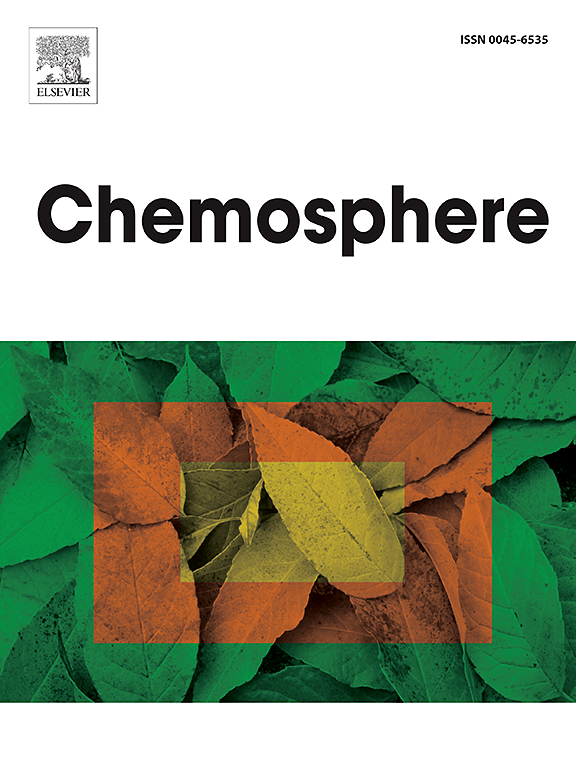A comparative study on in-situ synthesis of two iron nanoparticles in acid mine drainage using green tea and Excoecaria cochinchinensis leaves extracts
IF 8.1
2区 环境科学与生态学
Q1 ENVIRONMENTAL SCIENCES
引用次数: 0
Abstract
Acid mine drainage (AMD) is a type of wastewater characterized by elevated concentrations of heavy metals and metalloids, posing significant threats to ecosystems and human health. This study presents an eco-friendly method for in-situ synthesis of iron nanoparticles (FeNPs) in AMD using Excoecaria cochinchinensis leaves (EC) and green tea extracts (GT) as reducing/stabilizing agents, enabling simultaneous removal of heavy metals and metalloids. Results indicate that the two FeNPs (EC-FeNPs and GT-FeNPs) produced in AMD exhibited distinct structural and reactive properties. Firstly, the removal efficiencies of EC-FeNPs for As, Ni and Cd were 20.4 %, 15.31 %, and 11.62 %, respectively, while those of GT-FeNPs were 10.07 %, 11.7 % and 19.76 %, respectively. This indicates that EC-FeNPs were generally more effective than GT-FeNPs in removing heavy metals and metalloids from AMD. Secondly, EC-FeNPs (170.14 ± 3.22 nm) displayed larger particle sizes and more stable surface charges compared to GT-FeNPs (127.14 ± 1.94 nm), which could be attributed to differences in functional groups in the respective plant extracts. Thirdly, both EC and GT extracts acted as reductants and stabilizers in the synthesis of two FeNPs, with EC extracts providing a larger amount of phenolic compounds and carboxylic acids than GT extracts. Highlighted in this study is a novel approach for resource recovery and simultaneous removal of heavy metals and metalloids from AMD.

绿茶和薏苡仁叶提取物在酸性矿井水中原位合成两种铁纳米颗粒的比较研究
酸性矿山废水是一类以重金属和类金属浓度升高为特征的废水,对生态系统和人类健康构成重大威胁。本研究提出了一种在AMD中原位合成铁纳米颗粒(FeNPs)的环保方法,该方法以cocoecaria cochinchinensis叶片(EC)和绿茶提取物(GT)为还原剂/稳定剂,可同时去除重金属和类金属。结果表明,在AMD中生成的两种FeNPs (EC-FeNPs和GT-FeNPs)具有不同的结构和反应性质。首先,EC-FeNPs对As、Ni和Cd的去除率分别为20.4%、15.31%和11.62%,而GT-FeNPs对As、Ni和Cd的去除率分别为10.07%、11.7%和19.76%。这表明EC-FeNPs在去除AMD中的重金属和类金属方面通常比GT-FeNPs更有效。其次,EC-FeNPs(170.14±3.22 nm)比GT-FeNPs(127.14±1.94 nm)表现出更大的粒径和更稳定的表面电荷,这可能是由于两种植物提取物中官能团的差异。第三,EC和GT提取物在两种FeNPs的合成中都起到了还原剂和稳定剂的作用,EC提取物比GT提取物提供了更多的酚类化合物和羧酸。本研究的重点是一种资源回收和同时去除AMD中重金属和类金属的新方法。
本文章由计算机程序翻译,如有差异,请以英文原文为准。
求助全文
约1分钟内获得全文
求助全文
来源期刊

Chemosphere
环境科学-环境科学
CiteScore
15.80
自引率
8.00%
发文量
4975
审稿时长
3.4 months
期刊介绍:
Chemosphere, being an international multidisciplinary journal, is dedicated to publishing original communications and review articles on chemicals in the environment. The scope covers a wide range of topics, including the identification, quantification, behavior, fate, toxicology, treatment, and remediation of chemicals in the bio-, hydro-, litho-, and atmosphere, ensuring the broad dissemination of research in this field.
 求助内容:
求助内容: 应助结果提醒方式:
应助结果提醒方式:


